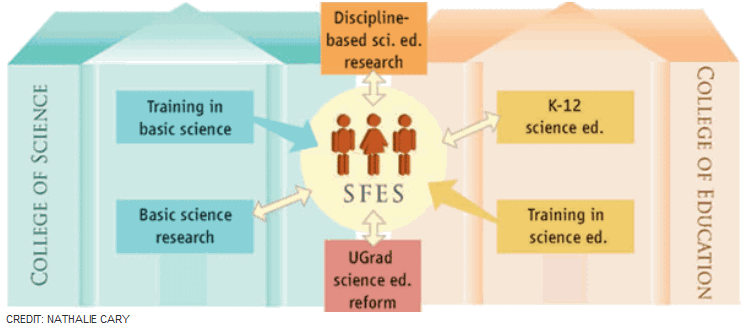|
|
|
|
|
|
|
News & Views item - December 2008 |
![]() Analysis of US Science Faculty with Education Specialties (SFES).
(December 20, 2008)
Analysis of US Science Faculty with Education Specialties (SFES).
(December 20, 2008)
Science's Education Form this week presents a statistically based study on the "seeding of university science departments with Science Faculty with Education Specialities (SFES)" -- specifically the 23 campuses of the California State University (CSU). As the authors point out "the CSU's primary missions are undergraduate, master's-level graduate, and K-12 teacher education"; they form the second tier of California's tertiary education system, coming directly below the University of California's ten campuses.
SEFS are defined as "scientists [with specialised educational training] who take on specialised roles within their discipline" and may be looked upon as an experiment to address the problem "in the United States, [where] primary and secondary (K-12) science education lags on international assessments and struggles to sustain qualified K-12 science teachers and to prepare the next generation of scientists and engineers".
Whether or not the approach is going to be viable is very much an open question as is clear from the conclusions drawn:
SFES are engaged broadly in science education as well as in basic science research... As a whole, SFES pursue funding for science education and basic science research and do not simply occupy teaching positions, as most report teaching about the same amount as their non-SFES colleagues... Our results quantify increased rates of hiring for SFES but also suggest potentially high attrition from these positions. The SFES model appears both promising and challenging. SFES in university and college science departments have the potential to drive science education reform at K-12 and postsecondary institutions. Our data suggest that science education would benefit from (i) increased training opportunities to develop SFES, (ii) reduced professional isolation for SFES, and (iii) improved academic infrastructure to support SFES research and professional activities.

Science 19 December 2008: Vol. 322. no. 5909, pp. 1795 - 1796 DOI: 10.1126/science.1162072
Almost 40% of those comprising the data set were "seriously considering leaving" their current jobs and of that 40% nearly all (95%) were considering leaving their particular position while 20% were considering leaving the field entirely.